Acer Aspire S7 Ultrabook: Acer’s Best Foot Forward
by Jarred Walton on January 7, 2013 4:30 AM EST- Posted in
- Laptops
- Acer
- Intel
- Ivy Bridge
- Aspire S7
- Ultraportable
- Ultrabook
Display Quality
Now we get to the one area where so many laptops fall short: the display. I’m a bit torn on the overall LCD experience, because on the one hand it’s the best LCD I’ve ever seen in an Acer laptop, but on the other hand there’s still room for improvement. Let’s start with the good news first: Acer is using a 1080p IPS touch screen, which means great viewing angles (which are necessary for any tablet-like experience). Contrast and maximum brightness are also good.
So what’s the problem? The problem is that there’s a reddish cast to the display and the color gamut as well as color accuracy—even after calibration—are not as good as we would like. Apple is still the company to beat for out-of-box color accuracy, and area they’ve greatly improved on with their latest devices.
We’ve been talking about LCD quality in mobile devices for over six years, and finally it looks like companies are heading in the right direction, but we want to get there faster. The ideal would be to have every display calibrated at the factory to provide relatively accurate colors, but barring individual calibration of panels, we’d be happy with the general LCD family targeting a 6500K white point with a sub-3.0 average DeltaE on the Gretag MacBeth color chart. That might sound like we’re asking for professional display quality, but let me point out that: 1) it’s now 2013 and professionals have had the tools to do this for over two decades; 2) we’re looking at a minimum $1400 MSRP laptop, so this isn’t a budget-friendly device to begin with.
Most consumers wouldn’t recognize accurate colors in the first place, and sadly when you’re at the store and a salesperson has two displays next to each other in the bright retail lights, many people will prefer the less accurate but brighter colors that the S7 currently delivers. Even without perfect colors, however, the Acer S7’s AU Optronics B133HAN03.0 v1 panel is pleasing to use. Here are the numbers.
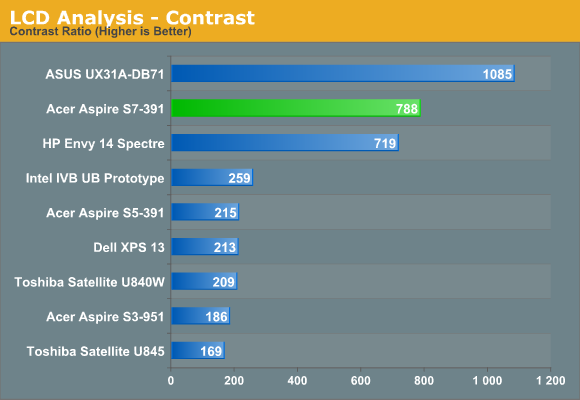
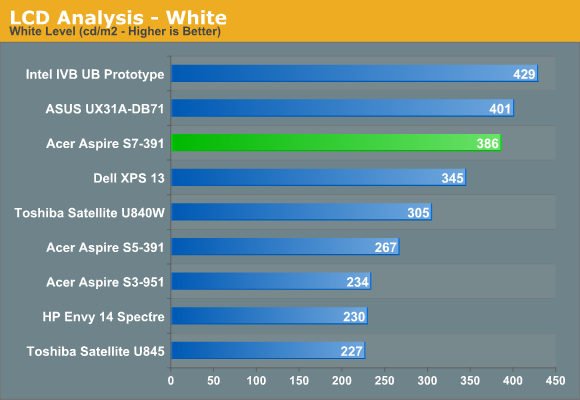
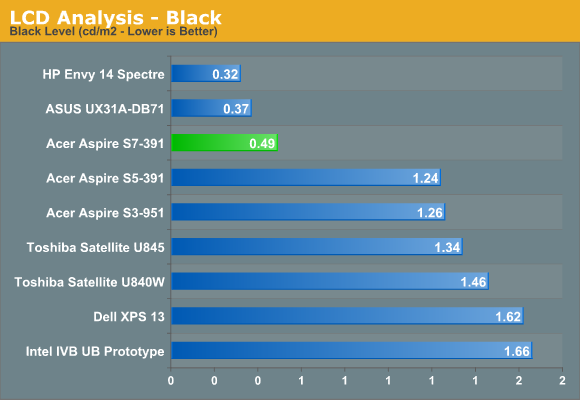
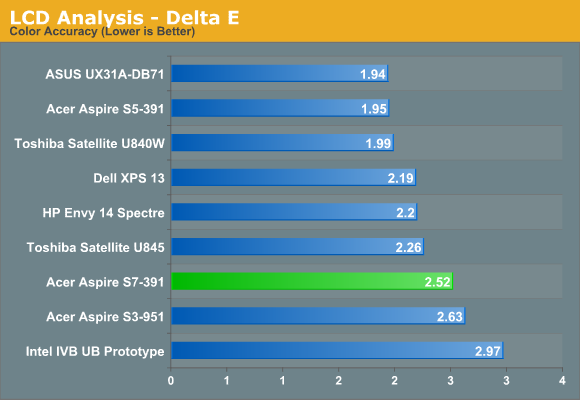
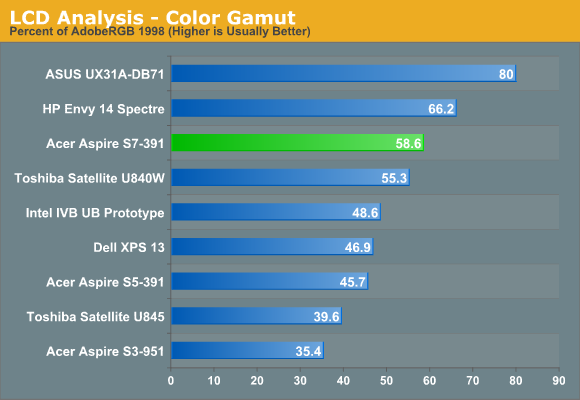
Contrast and brightness are good, though we’ve seen better. As I noted above with the colors being somewhat off before calibration, that carries over post-calibration with an average DeltaE that’s still around 2.5—ideally we’d like to see well under 2.0 for a quality display. The 58.6% color gamut is also less than what we’d like to see, which at a minimum would be the full sRGB color space (around 69%). What’s more, we chose the best calibration result for the above charts; with some of the other targets, the color gamut is a dismal 36%. If you’re okay with the native white point, you get a higher gamut, but if you want to target 6500K or D65, expect to see less than ideal results.










53 Comments
View All Comments
calyth - Monday, January 7, 2013 - link
Well, $500 laptop is fine for most uses, until you try to do anything that generates a lot of heat. Playing a game, converting video, etc etc.Most of the windows laptop in that range has heatsinks that copes with the average uses, but any spikes, and it would just wear out pretty quickly over time.
While MacBooks may have that aluminum frame advantage (in terms of heat dissipation), none of the current line up use anything particularly better than an Intel IGP. Getting the 650M requires $1700 bucks or more.
I don't particularly think that Acer's attempt here is bad, and Windows laptop gets close to Apple styling for more bang for the buck anyways. But for me, I kinda wish to get a decent laptop that could cope with work loads a little better, for reasonable cost, and not look like a brick (e.g. Dell Lattitudes). Thats' still not really happening.
Silma - Monday, January 7, 2013 - link
I almost purchased Acer's Aspire S7 but I didn't in the end because of the following shortcomings which are often shared by all PC manufacturers:- Acer, who do you think you are, mutilating the keyboard for no good reason?
- Battery. I would prefer a 1 or 2mm thicker Ultrabook any day for a (replaceable) decently sized battery, e.g. 70 Wh or more.
- Cooling and noise. Please add value, don't be an assembler and work harder on cooling and noise. Most owner reviews complain about both.
- Soldered memory. If you absolutely want to solder memory instead of making it upgradable, then you need to offer 8 GB at the very least, especially at this super premium price. Even better offer an Ultrabook with upgradable memory.
- Non replaceable SSD. Again, for a super-premium laptop, one should expect at least 3 years of usage, which means upgrading the SSD down the road.
It is really a shame as the following points made the Aspire S7 extremely endearing:
- Kudos for the choice of a touch-enabled, full HD and IPS panel, which makes this screen 3x better than most offering (hall of shame: Lenovo X1 Carbon super crappy screen at $1.5k +)
- Kudos for the aesthetic. It won't please all people, but at least it went further than most manufacturers
- Kudos for the very decent computing power.
DanNeely - Monday, January 7, 2013 - link
I've seen speculation elsewhere that it's the touchscreen that are responsible for the poorer battery life seen in w8 laptops vs their w7 ancestors; but I haven't seen anyone try to confirm this by disabling it and rerunning any of the battery tests.CadentOrange - Monday, January 7, 2013 - link
We've established that they're gunning for Macbook air prices, but other than that is it really comparable?How does the keyboard feel? I've seen the keyboard panned in the Ars review, and I tend to agree with them. If I'm spending $1500 on a laptop, I'd like a keyboard that doesn't feel clobbered together. Where are the function keys? Why is there no space between the "\" key and "Enter"? Does that annoy in practice?
The battery life is abysmal. If you're going to charge as much as an Air, you really should perform like an Air. I'm no Apple fanboy, I have a 2nd hand Macbook and all my other PCs and server run Linux. It's in my interest that PC manufacturers produce products that rival Apple's. This is sadly not even close.
KPOM - Monday, January 7, 2013 - link
Compared to the 13.3" MacBook Air with 256GB, which retails for $1499 with the 1.8GHz i5 and $1599 with 2.0GHz i7, the Asus has a better display (1920x1080 IPS touchscreen vs 1440x900 TFT non-touch), a processor that splits the difference, and lighter weight. Battery life is a bit disappointing, but overall it looks like a competitive package. The challenge is that PC buyers aren't used to paying these kinds of prices. The quality appears to be there (though the keyboard discussion is a bit worrying).ananduser - Monday, January 7, 2013 - link
The machine reviewed is an Acer not an Asus.Death666Angel - Monday, January 7, 2013 - link
Those are the things I would like to see. I don't want RAID 0, the battery needs to be bigger for me (and I don't care that much about height, so make it 2cm and double the capacity or something) and 4GB of RAM are a joke in this day and age. The rest looks fine enough. :)Tech-Curious - Monday, January 7, 2013 - link
Yeah, the RAID and the RAM are the dealbreakers for me -- and perhaps amusingly, those are the two cheapest things to fix. Switch off RAID and instantly the value proposition of the storage system is doubled. As for the memory, yeah; my old Clevo laptop's 4GB of RAM was impressive back in early 2008. Now, not so much. C'mon Acer, spring for 8GB.Those two changes represent maybe $30 of extra cost in parts, but they'd increase the perceived value of the whole product by $200-300, IMO, and maybe more to the general consumer.
I wonder how much money Acer would save by swapping out the touch screen. :)
Death666Angel - Monday, January 7, 2013 - link
I would like to meat the person who made those 2 decisions and get their explanation for it. With graphics cards, companies/marketing brag about 3GB on a GT630 or something, but with many Ultrabooks, they don't deliver even though the added cost is likely to be very low.Also, the missing F-Keys is not very nice. I don't use them super frequently, but they do add to my productivity in certain scenarios and it looks like they would have fitted on the laptop easily.
And lastly, I just ran Kraken on my desktop PC (i7 860 which is quite old by PC standards): 2515.1ms +/- 2.7%... didn't expect that much to be honest. :)
Death666Angel - Monday, January 7, 2013 - link
And my Galaxy Nexus manages 25,728.6ms /+-11.9%. That is strange.